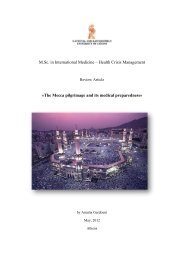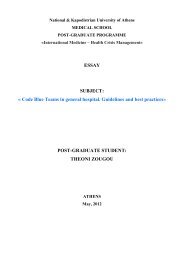AMOEBIASIS- J.J. Kambona [Compatibility Mode]
AMOEBIASIS- J.J. Kambona [Compatibility Mode]
AMOEBIASIS- J.J. Kambona [Compatibility Mode]
Create successful ePaper yourself
Turn your PDF publications into a flip-book with our unique Google optimized e-Paper software.
<strong>AMOEBIASIS</strong><br />
Presenter: J.J. <strong>Kambona</strong><br />
(M.B.Ch.B; M.Med)
OBJECTIVES<br />
At the end of this session each student will be able to:<br />
1. Define amoebiasis.<br />
2. Describe the epidemiology of amoebiasis.<br />
3. Describe the cause of amoebiasis.<br />
4. Describe the pathophysiology of amoebiasis.<br />
5. Describe the clinical features of amoebiasis.<br />
6. Describe the complications of amoebiasis.<br />
7. Describe the differential diagnoses of amoebiasis.<br />
8. Investigate patients with amoebiasis.<br />
9. Treat patients with amoebiasis.<br />
10.Describe the prognosis of patients with amoebiasis.<br />
11.Describe the preventive measures to amoebiasis.
Definition<br />
• Amoebiasis is an infestation<br />
caused by the protozoal<br />
organism, Entamoeba histolytica.
Epidemiology<br />
• Prevalence:<br />
The prevalence of amoebic colitis and<br />
amoebic liver abscess is estimated to be<br />
10% of the world population.<br />
• It is as high as 50% in areas of central and<br />
south America, Africa and Asia.
Epidemiology<br />
Individuals at risk of amoebiasis:<br />
• Travellers to endemic regions.<br />
• Recent immigrants from endemic regions.<br />
• Homosexual males.<br />
• Immunocompromised persons.<br />
• Institutionalized individuals.
Epidemiology<br />
Age:<br />
Younger children appear to be at higher<br />
risk.<br />
Sex:<br />
• Amoebic liver abscess is 7-12 times more<br />
common in men than in women.<br />
• Amoebic colitis affects both sexes equally.
Epidemiology<br />
Transmission:<br />
Common:<br />
• Food-borne exposure; especially when food<br />
handlers are shedding cysts or food is cultivated<br />
in faeces-contaminated soil, fertilizer or water.<br />
Uncommon:<br />
• Contaminated water.<br />
• Ano-oral sexual practices.<br />
• Direct rectal inoculation through colonic irrigation<br />
devices.
Cause<br />
• Entamoeba histolytica.<br />
• It is a pseudopod-forming, non-flagellated<br />
protozoa that exerts a lytic effect on<br />
tissues, a characteristic for which the<br />
organism named.
Pathophysiology<br />
• Ingestion of the amoebic cyst is followed by<br />
excystation in the small bowel and trophozoites<br />
colonization of the colon.<br />
• Upon colonization of the colonic mucosa, the<br />
• Upon colonization of the colonic mucosa, the<br />
trophozoites may encyst and be excreted in<br />
faeces or it may invade the intestinal mucosal<br />
barrier, thereby gaining access to the circulation,<br />
resulting in the involvement of the liver, lung and<br />
other sites.
Pathophysiology<br />
The host cells are then killed via the induction of<br />
apoptosis.<br />
Factors that may influence infestations (Whether<br />
the infestation to result into colonization or<br />
invasion) are:<br />
• Interaction with bacterial flora.<br />
• Host genetic susceptibility.<br />
• Malnutrition.<br />
• Sex.<br />
• Age.<br />
• Immunocompentence.
Clinical features<br />
A. History:<br />
• Asymptomatic intestinal amoebic infestation<br />
occurs in 90-99% of infected individuals.<br />
I. Amoebic colitis:<br />
• Abdominal pain.<br />
• Stools are bloody, mucoid and loose.<br />
• Fever (uncommon).<br />
• Weight loss.<br />
• Symptoms of volume depletion e.g.<br />
orthostasis.
II.<br />
Amoebic liver abscess<br />
• Fever.<br />
• Right hypochondrial pain.<br />
• Weight loss.<br />
• History of amoebic dysentery within the<br />
previous year may be present.<br />
• History of alcohol abuse is common, but<br />
how this condition may contribute to the<br />
development of a liver abscess still<br />
unclear.
III.<br />
Pleuropulmonary amoebiasis<br />
It is caused by the rupture of a superior right<br />
upper lobe liver abscess with erosion through<br />
the diaphragm.<br />
Manifestations:<br />
• Rigid abdomen.<br />
• Cough.<br />
• Pleuritic chest pain.<br />
• Difficult in breathing.<br />
• Occasional necrotic sputum production.
History<br />
IV.<br />
Intraperitoneal rupture of amoebic<br />
liver abscess (2-7%).<br />
V. Cerebral amoebiasis: (rare)<br />
• Abrupt onset of mental status change.<br />
• Focal neurological deficit.<br />
VI.<br />
Amoeboma (uncommon).<br />
VII. Rectovaginal fistulae (uncommon).
VIII. Fulminant or necrotizing colitis<br />
It is the most serious but uncommon.<br />
Predisposing factors:<br />
• Poor nutrition.<br />
• Pregnancy.<br />
• Corticosteroid use.<br />
• Very young age.
Physical examination<br />
I. Amoebic colitis:<br />
Fever.<br />
Weight loss.<br />
<br />
Diffuse abdominal tenderness.<br />
Fulminant colitis:<br />
• Abdominal pain.<br />
• Abdominal distension.<br />
• Rebound tenderness.
Amoebic liver abscess<br />
• Right upper quadrant abdominal<br />
tenderness.<br />
• Fever.<br />
• Weight loss.<br />
• Hepatomegaly.<br />
• Jaundice.
Complications<br />
I. Amoebic colitis:<br />
• Fulminant or necrotizing colitis.<br />
• Toxic megacolon.<br />
• Amoeboma.<br />
• Rectovaginal fistulae.<br />
II. Amoebic liver abscess:<br />
• Intrathoracic or intraperitoneal rupture with or<br />
without secondary bacterial infection.<br />
• Direct extension to pleura or pericardium.<br />
III. Brain abscess.
Differential diagnoses<br />
I. Amoebic liver abscess:<br />
• Hepatocellular carcinoma.<br />
• Pyogenic liver abscess.<br />
• Abdominal abscess.<br />
• Echinococal cyst.<br />
• Hepatitis.
Differential diagnoses<br />
II. Amoebic colitis:<br />
• Campylobacter jejuni infection.<br />
• Inflammatory bowel disease.<br />
• Arteriovenous malformation.<br />
• Escherichia coli infection.<br />
• Ischaemic colitis.<br />
• Salmonellosis.<br />
• Diverticulitis.<br />
• Shigellosis.
Investigations<br />
1. Microscopy:<br />
• Stool sample.<br />
• Amoebic liver abscess aspirate.<br />
2. Antigen detection by using monoclonal<br />
antibodies specific for galactose lectin.<br />
3. Serum anti-amoebic antibody test.<br />
4. Polymerase chain reaction.<br />
• Stool sample.<br />
• Amoebic liver abscess aspirate.
Investigations<br />
5. Ultrasound scans of the liver.<br />
• Amoebic liver abscess appears as a<br />
homogenous hypoechoic round lesion.<br />
6. Computed tomography scan: (with contrast)<br />
• Amoebic liver abscess appear as a rounded,<br />
low-attenuation lesion with an enhancing ring.<br />
• The abscess may be homogenous or septated<br />
with or without observable fluid levels.
Procedure<br />
Colonoscopy:<br />
Indications:<br />
• Stool and serology negative results in a patient thought<br />
to have amoebic colitis.<br />
Contraindication: Fulminant colitis.<br />
Findings:<br />
• Amoebic colitis: It may resemble that of inflammatory<br />
bowel disease, with a friable and diffusely ulcerated<br />
mucosa.<br />
• An Amoeboma may be present in a form of annular<br />
lesions, which usually occurs in the caecum and<br />
ascending colon and usually indistinguishable from<br />
colonic carcinoma.
Medical treatment<br />
Indications for admission:<br />
• Severe colitis requiring intravenous<br />
volume replacement.<br />
• Fulminant colitis that may require surgical<br />
intervention.<br />
• Liver abscess of uncertain aetiology or not<br />
responding to antibiotic therapy.<br />
• Suspected amoebic liver abscess rupture.
Asymptomatic patients<br />
Luminal agents:<br />
They are effective against trophozoites<br />
and cysts forms of Entamoeba<br />
histolytica.<br />
1. Iodoquinol: 650 mg PO TID for 20 days.<br />
2. Paromomycin: 25-35 mg/kg/ day PO in<br />
3 divided doses for 7 days.<br />
3. Diloxanide furoate: 500 mg PO TID for<br />
10 days.
Invasive diseases<br />
Examples:<br />
• Amoebic colitis.<br />
• Amoebic liver abscess.<br />
Drugs:<br />
The drugs are effective against anaerobic bacteria and<br />
protozoa.<br />
1. Metronidazole: 500-750 mg PO TID for 10 days. Or<br />
2. Tinidazole:<br />
• Intestinal amoebiasis: 600 mg PO BID for 5 days.<br />
• Alternative: 2 g PO OD for 3 days with food.<br />
• Amoebiasis liver abscess: 2 g PO OD for 3-5<br />
days with food.<br />
NB: Plus luminal agents.
Surgical treatment<br />
Indications:<br />
• Perforation of viscus.<br />
• Persistent abdominal distension and tenderness<br />
despite anti-amoebic therapy.<br />
NB:<br />
Surgical interventions for intrathoracic or<br />
intraperitoneal rupture of an amoebic liver<br />
abscess is rarely indicated, except in cases<br />
complicated by secondary bacterial infection.
Prognosis<br />
The prognosis of cure following treatment<br />
of invasive amoebiasis is good.<br />
Mortality:<br />
• Fulminant or necrotizing colitis: > 40%.<br />
• Amoebic colitis: 1.9-9.1%.
Prevention<br />
• Eradicate food and water contamination through<br />
sanitation, hygiene and water treatment.<br />
Water should be boiled and vegetables should<br />
be washed with a detergent soap and soaked in<br />
acetic acid or vinegar for 10-15 minutes before<br />
consumption.<br />
• Avoid ano-oral sexual practice.<br />
• Screen family members or close contacts of an<br />
index case.
Thank you for your attention
Reference<br />
• Kavis K., Cantey J.R., and Sword<br />
Robert. Amoebiasis;<br />
www.emedicine.com/med/topic116.htm<br />
Last updated: February 21, 2007.


![AMOEBIASIS- J.J. Kambona [Compatibility Mode]](https://img.yumpu.com/21968925/1/500x640/amoebiasis-jj-kambona-compatibility-mode.jpg)
![CHOLERA- Dr. J.J. Kambona [Compatibility Mode]](https://img.yumpu.com/21968930/1/190x135/cholera-dr-jj-kambona-compatibility-mode.jpg?quality=85)

